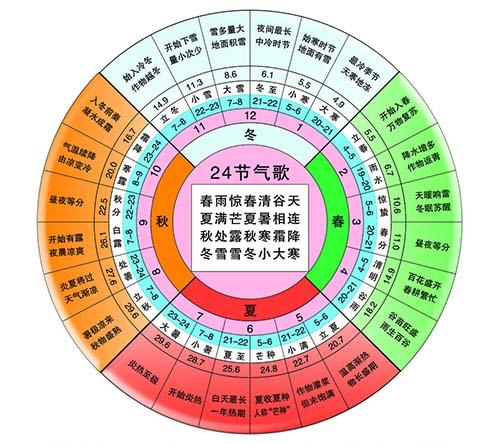(单词翻译:单击)
The 24 Solar Terms
24节气
The 24 solar terms is a gross name of the system that comprises of 12 major solar terms and 12 minor solar terms interlaced with each other.
二十四节气是一个统称,其中包括十二个中气和十二个节气,中气和节气相间地排列。
Starting from “vernal equinox”,the 12 major solar terms are “vernal equi-nox”,“corn rain”,“corn forms”,“summer solstice”,“great heat”,“end of heat”,“autumnal equinox”,“frost”,“light snow”,“winter solstice”,“severe cold” and “spring showers”. Each major solar term falls on one of the 12 lunarmonths designated by the 12 earthly branches.
从春分起十二个中气分别是春分、谷雨、小满、夏至、 大暑、处暑、秋分、霜降、小雪、冬至、大寒和雨水,分属于12个以地支排列的月份。
The minor solar term after “vernal equinox” is “bright and dear”,and then in turn “summer commences”,“corn on ear”,“ moderate heat”,“autumn commences”,“white dew”,“cold dew”, “winter commences”,“heavy snow”,“ moderate cold ”,“spring commences” and “ insects waken”.
春分后的节气是清明,其后的节气依次是立夏、芒种、小暑、立秋、白露、寒露、立冬、 大雪、小寒、立春和惊蛰。From the Earth’s perspective,the Sun moves through a year across the stars or celestial sphere along a path known as the ecliptic, which is measured in 360 degrees longitude.
从地球上观测,太阳一年里在恒星间或天球划过的轨道称为黄道,以360度黄经来量度。
The 24 solar terms divide the ecliptic into 24 equal segments, with 15 degrees of the Sun’s longitude between the terms.
二十四节气正好把黄道分成24等份,即每个节气相差黄经15度。
At“vernal equinox”,the Sun’s;s longitude is 0 degree; at “bright and clear”, the Sun’s;s longitude is 15 degrees; and so forth.
春分时黄经为0度,清明时黄经为15度,依此类推。
At “vernal equinox” and “autumnal equinox”,the periods of daylight and the night are equal in length.
春分和秋分昼夜平分。
The period of daylight is the longest at “summer solstice” and the shortest at “winter solstice”(northern hemisphere).
夏至昼最长(北半球,下同),冬至昼最短。
These were the earliest solar terms determined in ancient time.
春分、秋分、夏至和冬至是古人最初确立的节气。
Then it came the four solar terms “spring commences”,“summer commences”,“autumn commences” and “winter commences”.
其后加入的是立春、立夏、立秋和立冬。

Other solar terms were named later according to the weather and agricultural activities prevalent at the respective times of the seasons. The “24 solar terms” reflects to some extent the climate over central China in ancient time.
至于其他的节气,便以该段季节常见的天气现象或农业活动而命名,这些节气从某种程度上反映了古代中原地区的气候。
Each lunar month in the Agricultural Calendar contains a major solar term. A lunar month that does not include a major solar term is taken as the leap month of the preceding month.
农历规定每一个月必定要有一个中气,没有中气的月份,便成为前一个月的闰月。
In 19 tropical years there will be 228 major solar terms and 235 synodic months. So 7 lunar months will not contain major solar terms and they are classified as leap months.
原来19个“回归年”共有228个中气和235个“朔望月”,即有7个月没有中气,这些没有中气的月便正好成为闰月。


